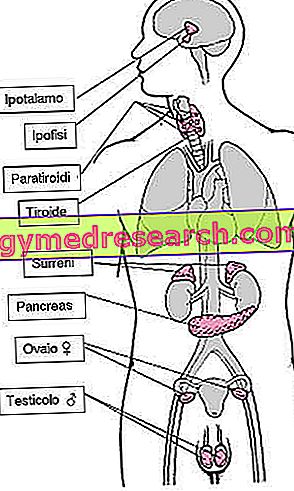The endocrine system is formed by a group of organs, called endocrine glands, whose main function is the secretion of hormonal substances.

HIPOTALAMUS, the central region of the Central Nervous System, is the coordinating center of endocrine system activities.
It produces factors of release and inhibition of the secretion of pituitary tropins (CRH, TRH, GHRH, somatostatin, GnRH).
THE HIPOFISIS, an endocrine gland placed inside the sella turcica of the sphenoid bone, is composed of an epithelial portion, the adenohypophysis responsible for the secretion of the pituitary tropins, and a nerve, the neurohypophysis responsible for the secretion of vasopressin
HYPOPHYSYSTEMS are hormones that control endocrine glands, which regulate trophism and secretory function.
ACTH: adrenocorticotropic hormone → adrenal → cortisol, adrenal steroids
TSH: thyroid-producing hormone → thyroid → thyroid hormones
GH: somatotropic hormone → IGF-1 → organs and tissues
PROLACTIN: lactotropic hormone → mammary gland and other tissues
LH: luteotropic hormone → gonads → sex hormones
FSH: follicle-stimulating hormone → gonads → sex hormones
Hormone articles
MECHANISM OF ACTION OF HORMONES
The biological functions of hormones take place with three different mechanisms:
Endocrine = the hormone produced at the level of the endocrine gland reaches the target tissue via the circulatory stream.
Paracrine = the hormone produced at the level of the endocrine gland reaches the target tissue through the extra-cellular liquid.
Autocrine = the hormone produced at the level of the endocrine gland affects the same cells that produced it.
Pheromone = transmitted between cells of different organisms.
Hormones can be secreted
in active form (GH, insulin);
in an inactive form, post-secretory activation processes (thyroid hormones, testosterone, vitamin D);
with short / medium / prolonged latency;
starting from very small reserves (peptide hormones) or large deposits (eg thyroid hormones).
Hormones can be placed in the circulatory stream
In free form (many protein / water-soluble hormones, catecholamines);
bound to carrier proteins (liposoluble steroid hormones with SHBG and CBG; thyroid hormones → TBG; more albumin).
The biological effect determined in a cell by a hormone depends on
hormonal concentration;
concentration of receptors;
degree of affinity between hormone and receptors.
The hormone binds a finite number of receptors . The receptor density of the target cell may vary depending on the phase of the cell cycle, or events related to differentiation or the current metabolic state.
The target cell can regulate the number of receptors depending on the hormonal concentration: a high hormonal concentration corresponds to a reduced receptor density and vice versa.
MEMBRANE RECEPTORS
consisting of an extracellular portion capable of sterically interacting with a specific message, a transmembrane portion and an intracellular portion capable of releasing suitable messages.
CITOPLASMATIC AND / OR NUCLEAR RECEPTORS
Nuclear receptors comprise a family of transcription factors that regulate gene expression in a ligand-dependent manner. Members of the nuclear receptor superfamily include receptors for steroid hormones (estrogens, glucocorticoids, androgens, mineralocorticoids), receptors for non-steroidal ligands (thyroid hormones, retinoic acid) and receptors that bind various products of lipid metabolism (fatty acids, prostaglandins ). Then there are the receptors whose ligands are still not known, the so-called "orphan receptors", probably recognized by low molecular weight ligands.
Nuclear receptors, with some exceptions, have a common structure:
a carboxy-terminal domain of interaction with the ligand (ligand binding domain, LBD)
a domain of interaction with DNA (DNA binding domain)
an extremely variable functional amino-terminal domain
ENDOCRINE DISEASES
Endocrine disorders can be grouped into four broad categories:
excessive hormonal production
deficit hormonal production
altered tissue response to hormones
neoplasms of the endocrine glands



